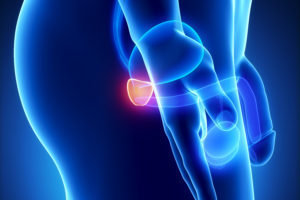Does Having An Enlarged Prostate (BPH) Affect Sexual Performance?
What is benign prostatic hyperplasia (BPH)?
As you get older, your body suffers some changes, one of them being the prostate enlargement. The prostate is a walnut-sized gland located between the bladder and the penis. It surrounds part of the urethra, the tube that carries urine and semen out of your penis. The prostate secretes a fluid that nourishes and protects sperm. During ejaculation, the prostate squeezes this fluid into the urethra and it’s expelled with sperm as semen.
The enlargement of the prostate represents a natural part of ageing, but in some points, it can lead to a condition called BPH. BPH is a non-malignant disease. This means that it is not cancer and it does not cause nor lead to cancer.

What are the signs and symptoms of BPH?
As the prostate gets bigger, it can place pressure on the bladder and urethra. An enlarged prostate gland can cause uncomfortable urinary symptoms, such as blocking the flow of urine out of the bladder. It can also cause bladder, urinary tract or kidney problems.
The most common signs and symptoms of BPH include:
- Frequent or urgent need to urinate;
- Increased frequency of urination at night (nocturia);
- Difficulty starting urination;
- Weak urine stream or a stream that stops and starts;
- Dribbling at the end of urination;
- Inability to completely empty the bladder.
Less common signs and symptoms include:
- Urinary tract infection;
- Inability to urinate;
Blood in the urine.
Prostate issues can also cause sexual problems. The extent of any sexual problem varies according to the condition of the prostate. Some common sexual side effects include:
- Erectile dysfunction;
- Reduced sexual satisfaction;
- Problems maintaining an erection;
- Decreased libido.
What causes BPH?
BPH occurs mainly in older men, but its cause is not well understood. The condition does not occur in men whose testicles were removed before puberty. Considering this, some researchers believe that factor related to testicles may cause prostate enlargement.
The cause of BPH is believed to be linked to hormonal changes which occur as you get older. The balance of hormones in your body changes as you get older and this may cause the prostate gland to grow.
Through their lives, men produce testosterone, a male hormone and small amounts of oestrogen, a female hormone. As men get older, the amount of active testosterone decreases, and high levels of oestrogen are found. Studies have shown that BPH may occur because the higher proportion of oestrogen within the prostate increases the activity of substances that promote prostate cell growth.
Another theory is focused on dihydrotestosterone (DHT), a male hormone that plays a role in prostate development and growth. Some studied concluded that even if the levels of testosterone are decreased in older men, they continue to produce and accumulate high levels of DHT in the prostate. This accumulation of DHT leads to the growth of the prostate cells.
What are the risk factors for BPH?
Risk factors for prostate gland enlargement include:
Ageing
The prevalence of BPH rises markedly with age. Prostate gland enlargement rarely causes signs and symptoms in men younger than age 40. About one-third of men experience moderate to severe symptoms by age 60 and about half do so by age 80.
Family history
BPH can run in families. Studies have pointed to a variety of genes that may have a role in the development of prostate enlargement.
Ethnic background
BPH can affect men of all ethnic backgrounds. The incidence is higher among African-Americans than in Caucasians, which in turn exceeds that in Asian men.
Diabetes
Studies suggest that diabetes has an important role in the development of BPH. Prostate enlargement can be triggered by high levels of insulin.
The hormone insulin normally moves sugar from foods out of the bloodstream to be used for energy or stored in cells. In people with type 2 diabetes, the body does not respond as well to insulin. Insulin levels are high but ineffective. The pancreas pumps out more insulin to bring down blood sugar. The excess of insulin stimulates the liver to produce more quantities of insulin-like growth factor. This factor is believed to trigger prostate growth.
Diet
There are some indications that both macronutrients and micronutrients may affect the risk of BPH.
Consumption of red meat, fat, milk and dairy products, cereals, bread, poultry and starch potentially increase the risks of BPH.
Vegetables, particularly carotenoids, fruits, polyunsaturated fatty acids, linoleic acid, vitamin A and vitamin D potentially decrease the risks of prostate enlargement.
For micronutrients, higher circulating concentrations of vitamin E, lycopene, selenium and carotene have been inversely associated with BPH. Zinc and vitamin C have been associated with both increased and decreased risk.
Lack of physical activity
Studies have shown that being sedentary could lead to prostate problems. Men who are inactive are more likely to develop BPH. Increased physical activity and exercise have been robustly and consistently linked with decreased risks of BPH surgery, clinical BPH, histological BPH. A meta-analysis of eleven published studies (n= 43,083 men) indicated that moderate to vigorous physical activity reduced the risk of BPH by as much as 25% relative to a sedentary lifestyle, with the magnitude of the protective effect increasing with higher levels of activity.
Metabolic syndrome and cardiovascular disease
Metabolic syndrome is a clinical constellation of metabolic abnormalities, including obesity, glucose intolerance, dyslipidaemia and hypertension that increase the risk of cardiovascular disease and results primarily from modifiable risk factors, particularly physical inactivity and dietary practices.
Data from clinical trials suggest that metabolic disturbances associated with cardiovascular diseases and lifestyle factors are associated with the risk of developing BPH.
Obesity
According to clinical trials results, increased adiposity is positively associated with the prostate volume. Body weight, body mass index (BMI) and waist circumference have all been positively associated with prostate volume in multiple different study populations.
It was also demonstrated that obesity increases the risks of BPH surgery, initiation of BPH medical therapy and decreases the efficacy of the pharmacological treatment.

How is BPH diagnosed?
The diagnosis of BPH includes two types of tests: basic tests and advanced tests.
Basic tests include:
- Blood tests to check for kidney problems
- Urine tests to look for infection or other problems that could be causing your symptoms
- PSA (prostate-specific antigen) blood test. High PSA levels may be a sign of a larger-than-usual prostate. A doctor can also order it as screening for prostate cancer.
Advanced tests include:
- Different types of ultrasound to measure your prostate and see if it looks healthy;
- A bladder ultrasound to see how well you empty your bladder;
- Biopsy to rule out cancer;
- A urine flow test to measure how strong your stream is and the quantity of urine;
- Urodynamics testing to evaluate your bladder function;
- Cystourethroscopy, a procedure using a camera to examine the inside of the prostate, urethra and bladder.
Does having an enlarged prostate (BPH) affect sexual performance?
Many men having BPH also experience erectile dysfunction and ejaculatory problems. However, BPH is not the only cause for these conditions. Some of the pharmacological treatments are also linked to sexual dysfunctions.
Pharmacological treatment for BPH includes two main classes of drugs:
- Alpha-blockers;
- 5-alpha reductase inhibitors;
The link between an enlarged prostate and erectile dysfunction
In the past, the relationship between BPH and erectile dysfunction was believed to be based solely on age. The risk of having enlarged prostate increases with age; so, does the risk of erectile dysfunction.
The link between BPH and erectile dysfunction was assessed in several clinical trials. One of the most important clinical trials was the Male Cologne Survey, including 4,489 men aged between 30 and 80. The study participants were questioned about their sexual activities and related factors. The results have shown that a high percentage of men who had lower urinary tract symptoms due to BPH also had erectile dysfunction.
Another study was the Multinational Survey of the Aging Male (MSAM-7). More than 14,000 men aged between 50 and 80 years were enrolled. The study confirmed that high prevalence of BPH associated with lower urinary tract symptoms is linked with to an increased risk of erectile dysfunction.
The relationship between BPH and erectile dysfunction was not clearly understood by the researchers. One idea concerns the sympathetic nervous system, which studies show is hyperactive in animals and men with BPH-associated urinary tract symptoms. Nerve fibres in the sympathetic nervous system transmit signals that have an impact on stress and stress-related symptoms. An increase in these signals may lead to overactivity in the sympathetic nervous system, which is associated with erectile problems.
How does the treatment for BPH cause erectile dysfunction?
Alpha-blockers
Alpha-blockers including alfuzosin, doxazosin, tamsulosin and silodosin relax smooth muscles, especially in the bladder neck and prostate which can improve urine flow. However, while they can be helpful in relieving BPH symptoms, in some patients they may also cause unwanted side effects such as impotence (erectile dysfunction), dry orgasm (retrograde ejaculation), and a decrease in the production of seminal fluids.
5-alpha reductase inhibitors
Research has shown that men who take these drugs for an enlarged prostate could be at higher risk for sexual problems, especially erectile dysfunction (ED), low libido, and trouble ejaculating.
5-alpha-reductase inhibitors represent a type of drug that is used to treat both BPH (enlarged prostate) and androgenic alopecia (male-pattern hair loss). Two examples of 5-alpha-reductase inhibitors are dutasteride and finasteride. These drugs are considered safe and effective for these two conditions, but they could have sexual side effects.
In a study published in 2016 by the Journal of Sexual Medicine, Chinese researchers analysed seventeen studies on 5-alpha reductase inhibitors and sexual function. The study included almost 17,500 men with an average age of 60 years. About 55% of men were treated with 5-alpha-reductase inhibitors while the rest received placebo.
The results of the studies showed that sexual problems were more common in men who took 5-alpha reductase inhibitors when compared to men who took a placebo. The dose of medication and the length of time were also important factors. Men who took 5-alpha reductase inhibitors for over a year were more likely to have sexual dysfunction. Sexual side effects were more common in men who administered 5-alpha reductase inhibitors for BPH compared with those who took the drugs for the treatment of male-pattern hair loss. This finding occurred because the doses of 5-alpha reductase inhibitors used for alopecia are smaller than the doses used for prostate enlargement. Also, men with an enlarged prostate are usually older than those experiencing hair loss and the likelihood of sexual dysfunction generally increases as a man ages.
Another study performed by the researchers from the Boston University School of Medicine showed that ED associated with long term use of finasteride for the treatment of BPH appears to worsen.
The study took a closer look at the sexual side effects experienced by men treated with long term finasteride use and compared them to men treated with tamsulosin, an alpha 1-adrenergic receptor blocker, which is also used to treat BPH. Seven hundred men were enrolled in the study. Of those, 470 (mean age 58) took 5 mg of finasteride each day. The remaining 230 men (mean age 63) took 0.4 mg of tamsulosin. The men were followed for up to 45 months.
Testosterone levels were checked every three months and at the follow-up appointments. The participants also completed the International Index of Erectile Function (IIEF).
Men who were treated with finasteride had declined IIEF scores, indicating poor erectile function. In contrast, the men taking tamsulosin did not experience any worsening of ED.
Total testosterone levels decrease for men taking finasteride, while in the tamsulosin group testosterone levels were normal.
Complications
Complications of BPH include:
- Sudden inability to urinate (urinary retention): You might need to have a tube (catheter) inserted into your bladder to drain the urine. Some men with an enlarged prostate need surgery to relieve urinary retention.
- Urinary tract infections: Inability to fully empty the bladder can increase the risk of infection in your urinary tract.
- Bladder stones: These are generally caused by an inability to completely empty the bladder.
- Kidney damage: Pressure in the bladder from urinary retention can directly damage the kidneys or allow bladder infections to reach the kidneys.

How can you prevent BPH?
The following lifestyle changes can prevent BPH:
- Eat more fruits and vegetables. Fruits and vegetables contain high levels of inflammation-fighting substances such as antioxidants, polyphenols, vitamins, minerals, and fibres. These foods which are rich in potent phytonutrients were shown to reduce the risk of developing an enlarged prostate.
- Eat healthful, low-fat foods. Research shows that men who consume a diet low in red meat and overall fat) are less likely to develop BPH. When choosing fats, be sure to focus on healthy ones (monounsaturated, omega-3) such as those found in avocados, nuts, cold water fatty fish, and plant oils such as olive oil.
- Choose plant protein over animal protein. Plant protein gives you all the nutrients and health benefits needed for maximum prostate health.
- Go for green tea. Green tea contains substances called catechins that travel throughout the body and take up residence in the prostate, where they can modulate the production and actions of hormones and may be useful in the treatment of BPH.
- Avoid foods, nutritional supplements and food additives that are harmful to prostate health.
- Achieve and maintain a healthy weight.
- Exercise regularly.
- Manage stress.
- Maintain hormone balance.
- Maintain a healthy sex life.
- Avoid exposure to toxins.
- Cut caffeine intake: Coffee, colas, some energy drinks, tea, and chocolate are likely caffeine sources and can irritate your prostate and worsen BPH symptoms.
- Cut back on spicy and salty foods: These foods can make BPH symptoms worse.
- Limit alcohol: A moderate amount of alcohol (1 to 2 drinks daily) is considered safe, but more than a moderate number of drinks can irritate the prostate and symptoms of BPH.
- Avoid use of over-the-counter antihistamines and decongestants: Use of these medications can aggravate BPH symptoms.
Keep diabetes under control.
References
- https://www.webmd.com/men/prostate-enlargement-bph/what-is-bph#1
- https://www.mayoclinic.org/diseases-conditions/benign-prostatic-hyperplasia/symptoms-causes/syc-20370087
- https://www.medicalnewstoday.com/articles/320954.php
- https://www.urologyhealth.org/urologic-conditions/benign-prostatic-hyperplasia-(bph)/causes
- Patel ND, Parsons JK. Epidemiology and aetiology of benign prostatic hyperplasia and bladder outlet obstruction. Indian J Urol. 2014 Apr;30(2):170-6. do: 10.4103/0970-1591.126900. PubMed PMID: 24744516; PubMed Central PMCID: PMC3989819.
- https://www.webmd.com/men/prostate-enlargement-bph/what-is-bph#2
- https://prostate.net/health-centers/bph-health-center/enlarged-prostate-erectile-dysfunction
- https://www.issm.info/sexual-health-qa/are-sexual-problems-linked-to-5ari-use-for-benign-prostatic-hyperplasia-bph/
- https://www.issm.info/news/sex-health-headlines/finasteride-use-associated-with-ed-low-testosterone/
- https://prostate.net/health-centers/bph-health-center/preventing-enlarged-prostate

